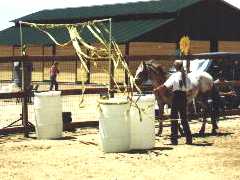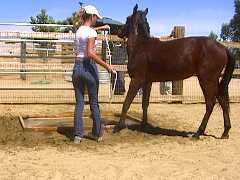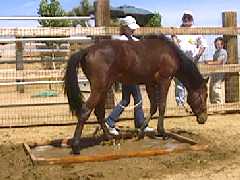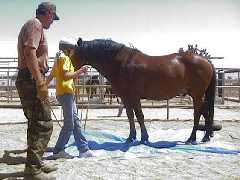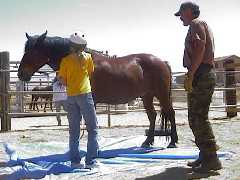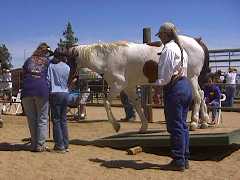Wild Horse Boot Camp Obstacles
|
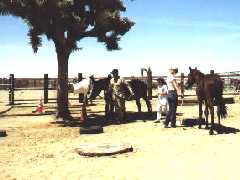
|
|
| |||
|
The waterfall consists of a row of plastic streamers suspended from a plastic pipe.
The purpose here is to keep the horse focused and moving quietly even though
the streamers are fluttering and touching him.
The horse should investigate the streamers but not shy from them. If the handler can keep the horse focused, he can deal with the stimulus of the streamers and still follow the handler's cues. |
Letting the horse check things out before moving through.
| ||
|
| |||
|
Once the horse will respond to the handler and maintain his position over the
simpler obstacles, we add more dimension to the problems.
The "water box" is a wooden box filled with water which quickly gets muddy. It contains sand so that the footing remains decent, but it is puzzling to the horse. Most horses will try to avoid the box by pulling away or pushing into the handler, especially if he is pressured too much. The are here is to keep the horse and trying focused without escalating the tempo. The horse's nature compels him to approach and retreat from strange objects until he is more sure of it. It's not so important that the horse immediately proceed through the water box as it is for the horse to check it out, keep coming back to it and focus on it until he goes through. The objective is to walk through the box, not run through or jump over it, and learn that the handler won't ask him to do anything he can't do. |
The horse won't cross with his head up and shoulder into the handler
| ||
|
| |||
|
Most horses don't like walking on plastic tarps. Tarps that ripple and billow
in the desert wind are even more challenging.
The rate at which this obstacle is attempted can't be so slow that the horse has a chance to worry over it, but it can't be so fast that the horse doesn't process what's going on and panics when the tarp moves. The horse may need to approach and retreat from this obstacle until he starts to understand it. If the wind is moving it a lot, the handler may have to walk on the tarp to control the amount of billowing and so that the horse can perceive that the tarp can be walked across. Once the horse takes the tarp at a sensible pace, it is desirable for him to stand on it quietly on a loose lead. |
A tentative walk over the moving ripples
| ||
|
| |||
|
By the end of this exercise, the horses were handling the various obstacles without worrying or scrambling even though they were led by a number of different handlers, large and small alike. |
Making it look easy!
| ||
|
Continue to the Bomproofing Course
Continue to More Obstacle FeaturesReturn to Part OnePress "Back" to return to the page that brought you hereGo to Case Study SectionReturn to Training SectionReturn to Wild Horse MentorsReturn to KBR World of Wild Horses and BurrosGo To
| |||

